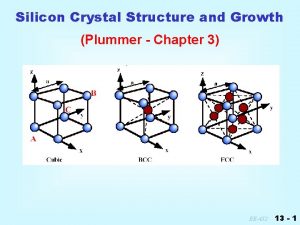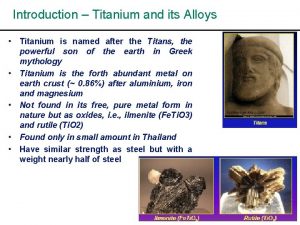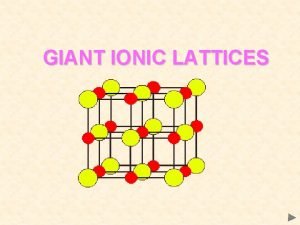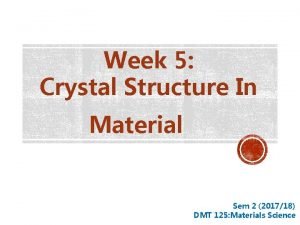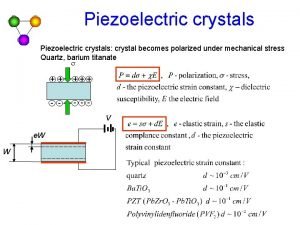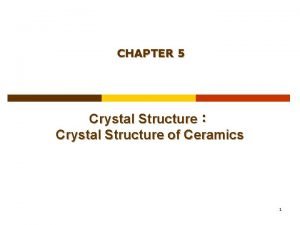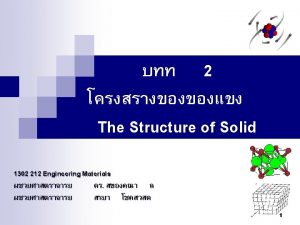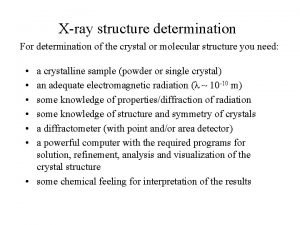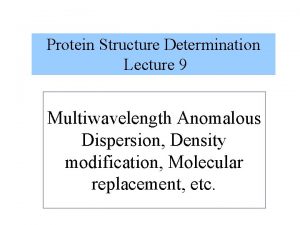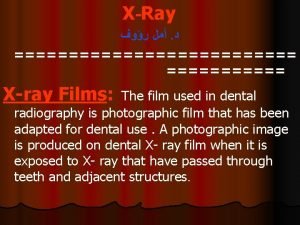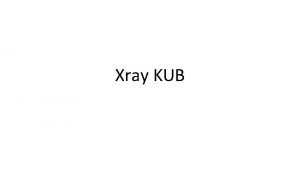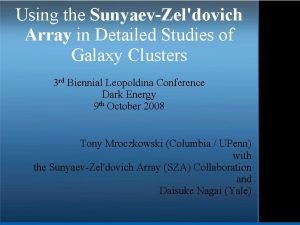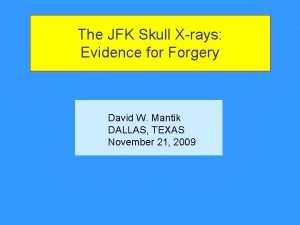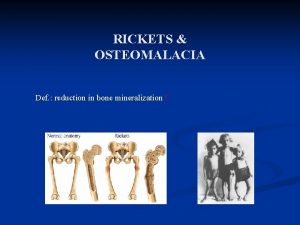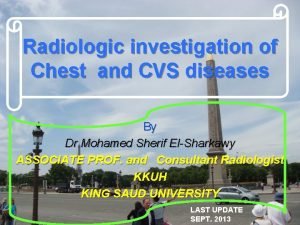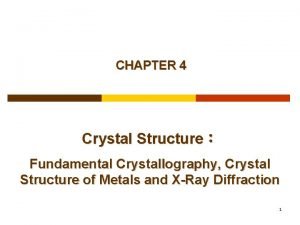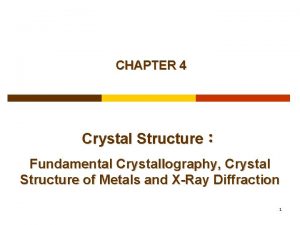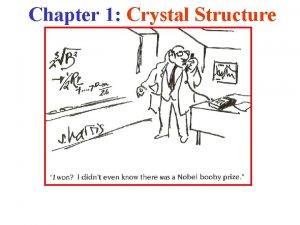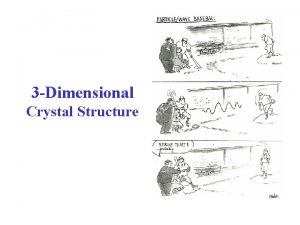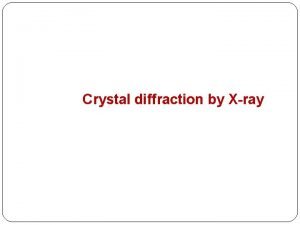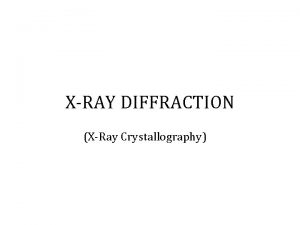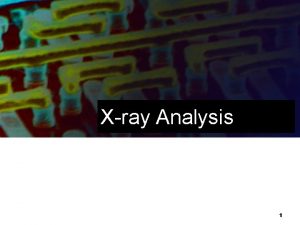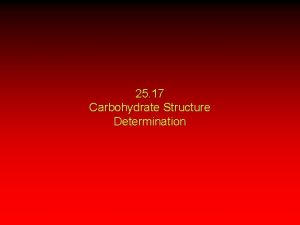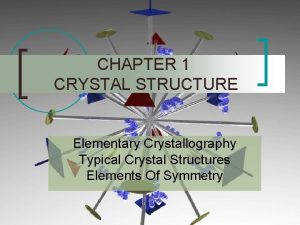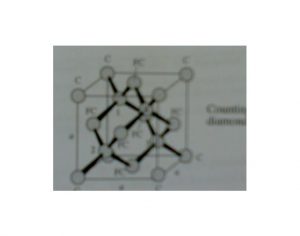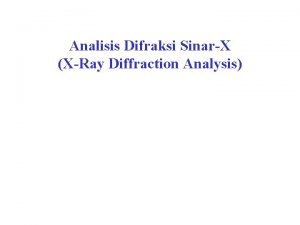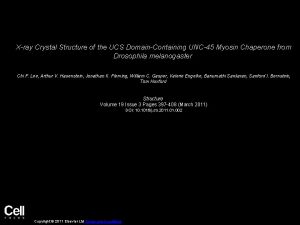Xray structure determination For determination of the crystal






















- Slides: 22

X-ray structure determination For determination of the crystal or molecular structure you need: • • • a crystalline sample (powder or single crystal) an adequate electromagnetic radiation (λ ~ 10 -10 m) some knowledge of properties/diffraction of radiation some knowledge of structure and symmetry of crystals a diffractometer (with point and/or area detector) a powerful computer with the required programs for solution, refinement, analysis and visualization of the crystal structure • some chemical feeling for interpretation of the results

Electromagnetic Radiation tranversal waves, velocity c 0 ≈ 3 · 108 m s-1 Characteristics 1. Energy (e. V, k. J mol-1) -frequency ( = c 0 / ; s-1, Hz) -wavelength ( = c 0 / ; Å, nm, . . . , m, . . . ) -wavenumber energy ~ frequency ~ wavenumber ~ wavelength-1 2. Intensity 3. Direction wavevector 4. Phase phase (E = h · ) (E = h · c 0 / ) cross-section Range of frequencies for structural analysis: 106 -1020 Hz i. e. 10 -12 – 102 m g-ray, x-ray, ultraviolet (UV), visible (VIS), infrared (IR), micro-, radiowaves

(X-ray) Diffraction of a Sample (gas, liquid, glass, (single-) crystal (-powder)) λ = 2 dhkl·sinθhkl detector I( ) (film, imaging plate) scattered beam 2 x-ray source incident beam stop sample Fouriertransform of the Electron-Density Distribution sample V : volume of sample diffr. pattern : vector in space R : scattering amplitude : scattering vector ≡ vector in Fourier (momentum) space

A. X-ray scattering diagram of an amorphous sample no long-range order, no short range order (monoatomic gas e. g. He) monotoneous decrease I( ) (n) I( ) = N·f 2 f = scattering length of atoms N no information no long-range, but short range order (e. g. liquids, glasses) modulation I( ) radial distribution function atomic distances

B. X-ray scattering diagram of a crystalline sample I( ) n· = 2 d sin crystal powder orientation statistical, fixed cones of interference Debye-Scherrer diagram single crystal orientation or variable dots of interference (reflections) precession diagram

Superposition (diffraction) of scattered X-rays - Bragg´s Law Only if nλ = 2 d∙sinθ or λ = 2 dhkl∙sinθhkl (Bragg‘s law, hkl: Miller indices), scattered X-rays are „in phase“ and intensity can be non-zero

Principle of Powder Diffraction A powder sample results in cones with high intensity of scattered beams. Above conditions result in the Bragg equation. or

Debye-Scherrer Geometry

Powder Diffractometer (Bragg-Brentano Geometry)

Powder Diffraction (Bragg-Brentano Geometry) Silver-Behenate n D 8 ADVANCE, n Cu radiation, 40 k. V / 40 m. A n Divergence slit: 0, 1° n Step range: 0. 007° n Counting time / step: 0. 1 sec n Velocity: 4. 2°/minute n Total measure. time: 3: 35 min.

Powder Diffraction (Bragg-Brentano Geometry) Sample: NIST 1976, corundum plate • • • D 8 ADVANCE, Cu radiation, 40 k. V, 40 m. A Step range: 0, 013° Counting time / step: 0, 02 sec Velocity: 39°/ min. Total measur. time: 3: 05 min.

X-ray structure analysis with a single crystal Structure refinement ← Fourier syntheses ← Phase redetermin. ← Intensities and directions only. Loss of phases ← Direction ≡ 2θ

Principle of a four circle X-ray diffractometer for single crystal structure analysis

CAD 4 (Kappa Axis Diffractometer)

IPDS (Imaging Plate Diffraction System)

Results Crystallographic and structure refinement data of Cs 2 Co(HSe. O 3)4· 2 H 2 O Name Figure Formula Cs 2 Co(HSe. O 3)4· 2 H 2 O Diffractometer IPDS (Stoe) Temperature 293(2) K Range for data collection 3. 1º ≤Q≤ 30. 4 º Formula weight 872. 60 g/mol hkl ranges -10 ≤ h ≤ 10 Crystal system Monoclinic -17 ≤ k ≤ 18 Space group P 21/c -10 ≤ l ≤ 9 Unit cell dimensions a = 757. 70(20) pm Absorption coefficient m = 15. 067 mm-1 b = 1438. 80(30) pm No. of measured reflections 9177 c = 729. 40(10) pm No. of unique reflections 2190 b = 100. 660(30) º No. of reflections (I 0≥ 2 s (I)) 1925 Volume 781. 45(45) × 106 pm 3 Extinction coefficient e = 0. 0064 Formula units per unit cell Z=2 ∆rmin / ∆rmax / e/pm 3 × 10 -6 -2. 128 / 1. 424 Density (calculated) 3. 71 g/cm 3 R 1 / w. R 2 (I 0≥ 2 s (I)) 0. 034 / 0. 081 Structure solution SHELXS – 97 R 1 / w. R 2 (all data) 0. 039 / 0. 083 Structure refinement SHELXL – 97 Goodness-of-fit on F 2 1. 045 Refinement method Full matrix LSQ on F 2

Results Positional and isotropic atomic displacement parameters of Cs 2 Co(HSe. O 3)4· 2 H 2 O Atom WS x y z Ueq/pm 2 Cs 4 e 0. 50028(3) 0. 84864(2) 0. 09093(4) 0. 02950(11) Co 2 a 0. 0000 1. 0000 0. 01615(16) Se 1 4 e 0. 74422(5) 0. 57877(3) 0. 12509(5) 0. 01947(12) O 11 4 e 0. 7585(4) 0. 5043(3) 0. 3029(4) 0. 0278(7) O 12 4 e 0. 6986(4) 0. 5119(3) -0. 0656(4) 0. 0291(7) O 13 4 e 0. 5291(4) 0. 6280(3) 0. 1211(5) 0. 0346(8) H 11 4 e 0. 460(9) 0. 583(5) 0. 085(9) 0. 041 Se 2 4 e 0. 04243(5) 0. 67039(3) -0. 18486(5) 0. 01892(12) O 21 4 e -0. 0624(4) 0. 6300(2) -0. 3942(4) 0. 0229(6) O 22 4 e 0. 1834(4) 0. 7494(3) -0. 2357(5) 0. 0317(7) O 23 4 e -0. 1440(4) 0. 7389(2) -0. 1484(4) 0. 0247(6) H 21 4 e -0. 120(8) 0. 772(5) -0. 062(9) 0. 038 OW 4 e -0. 1395(5) 1. 0685(3) 0. 1848(5) 0. 0270(7) HW 1 4 e -0. 147(8) 1. 131(5) 0. 032 HW 2 4 e -0. 159(9) 1. 045(5) 0. 247(9) 0. 032

Results Anisotropic thermal displacement parameters Uij × 104 / pm 2 of Cs 2 Co(HSe. O 3)4· 2 H 2 O Atom U 11 U 22 U 33 U 12 U 13 U 23 Cs 0. 0205(2) 0. 0371(2) 0. 0304(2) 0. 00328(9) 0. 0033(1) -0. 00052(1) Co 0. 0149(3) 0. 0211(4) 0. 0130(3) 0. 0006(2) 0. 0041(2) 0. 0006(2) Se 1 0. 0159(2) 0. 0251(3) 0. 01751(2) -0. 00089(1) 0. 00345(1) 0. 00097(1) O 11 0. 0207(1) 0. 043(2) 0. 0181(1) -0. 0068(1) -0. 0013(1) 0. 0085(1) O 12 0. 0264(2) 0. 043(2) 0. 0198(1) -0. 0009(1) 0. 0089(1) -0. 0094(1) O 13 0. 0219(1) 0. 034(2) 0. 048(2) 0. 0053(1) 0. 0080(1) -0. 009(2) Se 2 0. 0179(2) 0. 0232(2) 0. 0160(2) 0. 00109(1) 0. 00393(1) -0. 0001(1) O 21 0. 0283(1) 0. 024(2) 0. 0161(1) 0. 0008(1) 0. 0036(1) -0. 0042(1) O 22 0. 0225(1) 0. 032(2) 0. 044(2) -0. 0058(1) 0. 0147(1) -0. 0055(1) O 23 0. 0206(1) 0. 030(2) 0. 0240(1) 0. 0018(1) 0. 0055(1) -0. 0076(1) OW 0. 0336(2) 0. 028(2) 0. 0260(2) 0. 0009(1) 0. 0210(1) -0. 0006(1) The anisotropic displacement factor is defined as: exp {-2 p 2[U 11(ha*)2 +…+ 2 U 12 hka*b*]}

Results Some selected bond lengths (/pm) and angles(/°) of Cs 2 Co(HSe. O 3)4· 2 H 2 O Se. O 32 - anions Cs. O 9 polyhedron Cs-O 11 Cs-O 13 Cs-O 22 Cs-O 23 Cs-OW Cs-O 21 Cs-O 12 Cs-O 22 Cs-O 13 316. 6(3) 318. 7(4) 323. 7(3) 325. 1(3) 330. 2(4) 331. 0(3) 334. 2(4) 337. 1(4) 349. 0(4) O 22 -Cs-OW O 22 -Cs-O 12 O 23 -Cs-O 11 -Cs-O 23 O 13 -Cs-O 22 -Cs-O 22 O 11 -Cs-OW O 23 -Cs-O 22 78. 76(8) 103. 40(9) 94. 80(7) 42. 81(8) 127. 96(8) 65. 50(9) 66. 96(5) 54. 05(8) 130. 85(9) Co. O 6 octahedron Co-OW Co-O 11 Co-O 21 210. 5(3) 210. 8(3) 211. 0(3) OW-Co-OW OW-Co-O 21 OW-Co-O 11 Symmetry codes: 1. -x, -y+2, -z 4. x-1, -y+3/2, z-1/2 7. -x, y-1/2, -z-1/2 10. -x, y+1/2, -z-1/2 180 90. 45(13) 89. 55(13) 2. 5. 8. 11. Se 1 -O 11 Se 1 -O 12 Se 1 -O 13 Se 2 -O 21 167. 1(3) 167. 4(3) 177. 2(3) 168. 9(3) O 12 - Se 1 -O 11 O 12 - Se 1 -O 13 O 11 - Se 1 -O 13 O 22 - Se 2 -O 21 104. 49(18) 101. 34(18) 99. 66(17) 104. 46(17) Se 2 -O 22 Se 2 -O 23 164. 8(3) 178. 3(3) O 22 - Se 2 -O 23 O 21 - Se 2 -O 23 102. 51(17) 94. 14(15) Hydrogen bonds d(O-H) d(O…O) <OHO O 13 -H 11…O 12 O 23 -H 21…O 21 OW-HW 1…O 22 OW-HW 2…O 12 85(7) 78(6) 91(7) 61(6) 180(7) 187(7) 177(7) 206(6) 263. 3(5) 263. 7 (4) 267. 7 (5) 264. 3 (4) 166(6) 168(7) 174(6) 161(8) -x+1, -y+2, -z x, -y+3/2, z-1/2 -x+1, y+1/2, -z+1/2 -x+1, -y+1, -z 3. -x+1, y-1/2, -z+1/2 6. x, -y+3/2, z+1/2 9. x+1, -y+3/2, z+1/2 12. x-1, -y+3/2, z+1/2

Results Molecular units of Cs 2 Co(HSe. O 3)4· 2 H 2 O Coordination polyhedra of Cs 2 Co(HSe. O 3)4· 2 H 2 O Connectivity of the coordination polyhedra of Cs 2 Co(HSe. O 3)4· 2 H 2 O

Results Hydrogen bonds of Cs 2 Co(HSe. O 3)4· 2 H 2 O Anions and hydrogen bonds of Cs 2 Co(HSe. O 3)4· 2 H 2 O Crystal structure of Cs 2 Co(HSe. O 3)4· 2 H 2 O

 Zns crystal structure unit cell
Zns crystal structure unit cell Silicon crystal structure
Silicon crystal structure Titanium crystal structure
Titanium crystal structure Giant ionic structure
Giant ionic structure Face centered cubic coordination number
Face centered cubic coordination number Piezoelectric crystal atomic structure
Piezoelectric crystal atomic structure Lattice +basis is
Lattice +basis is Crystal structure of ceramics
Crystal structure of ceramics Ideal crystal
Ideal crystal Crystalline solid
Crystalline solid Metallic crystal structure
Metallic crystal structure What is motif in crystal structure
What is motif in crystal structure Single crystal diffractometer
Single crystal diffractometer Protein structure determination
Protein structure determination X ray mastoid towne's view position
X ray mastoid towne's view position Dental xray films
Dental xray films Plain film kub
Plain film kub Xray xml editor
Xray xml editor Sza xray
Sza xray Jfk x ray
Jfk x ray Tetralogy of fallot xray
Tetralogy of fallot xray Osteoid definition
Osteoid definition Hypoinspiratory
Hypoinspiratory

